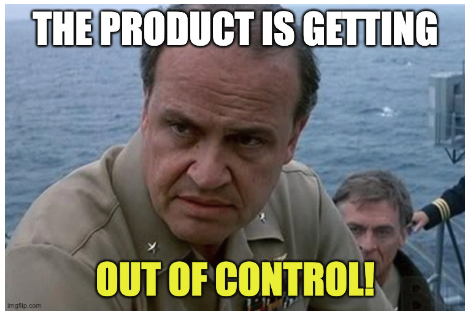
There's a lot of pressure on product managers to launch the products at hand. However, once you're behind the curtain, you can see what mistakes are being made. It is not easy to communicate your point of view when everyone around you is in a hurry for their success. But this article will help you spot some things.
Try the ultimate feedback collection tool for free
![]() No credit card required. No-code and 1 minute setup.
No credit card required. No-code and 1 minute setup.
Top 10 Mistakes Of Product Managers
As a product manager, there are several common mistakes that can hinder your effectiveness and the success of your product. Here are ten top mistakes that product managers should be aware of:
- Lack of clear product vision: Failing to define a clear and compelling vision for your product can lead to a lack of direction and purpose, making it difficult to make strategic decisions and communicate effectively with stakeholders.
- Insufficient market research: Neglecting thorough market research can result in building a product that doesn't meet customer needs or lacks competitive advantage. Understanding the market, target audience, and competitors is crucial for success.
- Poor prioritization: Without effective prioritization, product managers may find themselves overwhelmed by numerous features and requests. Prioritizing based on customer value, business goals, and impact is vital to allocate resources effectively.
- Inadequate user feedback and validation: Failing to gather and incorporate user feedback throughout the product development cycle can lead to building a product that doesn't resonate with the target audience. Regular user testing and validation are essential for making informed decisions.
- Lack of cross-functional collaboration: Product managers need to collaborate closely with various teams, such as engineering, design, marketing, and sales. Failing to foster strong cross-functional collaboration can result in misalignment, delays, and poor product outcomes.
- Scope creep and feature bloat: Allowing the product scope to expand beyond the initial vision can lead to feature bloat, longer development cycles, and a diluted user experience. It's important to maintain focus and resist the temptation to add unnecessary features.
- Poor communication and documentation: Inadequate communication and documentation can lead to misunderstandings, misalignment, and inefficiencies within the team. Clear and frequent communication, along with well-documented product requirements, is crucial for success.
- Overestimating timelines and underestimating complexity: Unrealistic timelines and underestimating the complexity of product development can result in missed deadlines, rushed releases, and compromised quality. Product managers should strive for realistic planning and buffer time for unexpected challenges
- Neglecting post-launch monitoring and iteration: Successful product management extends beyond the initial launch. Failing to monitor post-launch metrics, user feedback, and iterate accordingly can hinder the product's long-term success and growth.
- Ignoring the competition: Disregarding competitors and market trends can lead to missed opportunities and falling behind in the market. It's crucial for product managers to stay informed about the competitive landscape and adapt their strategies accordingly.
How these mistakes can be addressed
Here's a table, outlining the mistakes, their impact, and how product managers can address them, along with real-world examples:
| Mistake | Impact | How to Address | Real-World Example |
|---|---|---|---|
| Lack of clear product vision | Lack of direction, misalignment, and decision-making issues | Define and communicate a clear product vision and strategy | Example: A product manager for a ride-sharing app sets a vision to create the most convenient and reliable transportation service, guiding the team's roadmap and feature decisions. |
| Insufficient market research | Building a product that doesn't meet customer needs | Conduct thorough market research and competitive analysis | Example: A product manager for an e-commerce platform conducts market research to identify a gap in the market for customizable, eco-friendly products, leading to a successful product launch. |
| Poor prioritization | Overwhelmed by numerous features and requests | Prioritize based on customer value and business goals | Example: A product manager for a project management tool prioritizes features that enhance team collaboration and task management, aligning with the primary needs of their target customers. |
| Inadequate user feedback and validation | Building a product that doesn't resonate with users | Regularly gather user feedback and conduct user testing | Example: A product manager for a mobile banking app conducts usability testing with real users to identify pain points and enhance the user interface, resulting in improved user satisfaction. |
| Lack of cross-functional collaboration | Misalignment, delays, and poor product outcomes | Foster strong collaboration with engineering, design, etc. | Example: A product manager collaborates closely with designers and engineers to ensure seamless integration of new features, resulting in a more cohesive and polished user experience. |
| Scope creep and feature bloat | Longer development cycles and diluted user experience | Maintain focus on the initial vision and resist scope creep | Example: A product manager resists the temptation to add excessive features to a mobile gaming app, ensuring a streamlined experience and quicker development cycles, leading to higher user engagement. |
| Poor communication and documentation | Misunderstandings, misalignment, and inefficiencies | Ensure clear and frequent communication and well-documented product requirements | Example: A product manager maintains open communication channels, uses project management tools effectively, and provides detailed specifications to developers, resulting in fewer misunderstandings and smoother development processes. |
| Overestimating timelines and underestimating complexity | Missed deadlines, rushed releases, and compromised quality | Plan realistically and account for unexpected challenges | Example: A product manager factors in buffer time for unexpected issues during the development of a complex software product, allowing the team to deliver a high-quality release on schedule. |
| Neglecting post-launch monitoring and iteration | Hindered long-term success and growth | Monitor post-launch metrics, gather feedback, and iterate | Example: A product manager analyzes user feedback and behavior post-launch, identifying areas for improvement and iteratively enhancing the product, resulting in increased customer satisfaction and retention. |
| Ignoring the competition | Missed opportunities and falling behind in the market | Stay informed about the competitive landscape and adapt strategies accordingly | Example: A product manager for a food delivery app regularly monitors competitor offerings and quickly adopts features like real-time order tracking, staying competitive and meeting customer expectations. |
By addressing these mistakes, product managers can improve their decision-making, collaboration, and overall product success.
Use the magic word - No
"No" can be considered a "magic word" for product managers because it allows them to prioritize, set boundaries, and maintain focus on the most important initiatives. Here are a few reasons why "no" is important for product managers:
- Prioritization: Product managers often face numerous feature requests, ideas, and demands from stakeholders. Saying "no" helps them prioritize effectively and allocate resources to the most impactful and valuable initiatives.
- Scope Management: Product managers need to manage the scope of their products and prevent feature creep or excessive expansion. Saying "no" to unnecessary or low-value features helps maintain focus on the core functionalities and user experience.
- Resource Allocation: Product managers need to balance competing demands for engineering, design, and other resources. Saying "no" to certain projects or requests helps ensure that resources are allocated appropriately to achieve the best outcomes.
- Maintaining Product Vision: A strong product vision guides the development and evolution of a product. Saying "no" to ideas or features that deviate from the vision helps maintain consistency, clarity, and alignment with the intended direction.
- Time Management: Product managers have limited time and need to be able to manage their workload effectively. Saying "no" to commitments or requests that would overload their schedule allows them to focus on their core responsibilities and deliverables.
Try the ultimate feedback collection tool for free
![]() No credit card required. No-code and 1 minute setup.
No credit card required. No-code and 1 minute setup.
